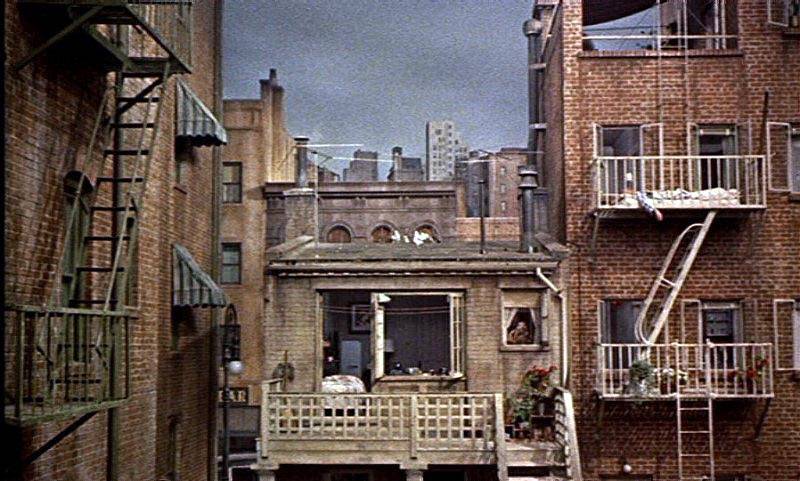Now this is a movie. Alfred Hitchcock’s “Rear Window” develops such a clean, uncluttered line from beginning to end that we’re drawn through it (and into it) effortlessly. The experience is not so much like watching a movie, as like … well, like spying on your neighbors. Hitchcock traps us right from the first.
As his hero, Jimmy Stewart, idly picks up a camera with a telephoto lens and begins to scan the open windows on the other side of the courtyard, we look too. And because Hitchcock makes us accomplices in Stewart’s voyeurism, we’re along for the ride. When an enraged man comes bursting through the door to kill Stewart, we can’t detach ourselves, because we looked too, and so we share the guilt and in a way we deserve what’s coming to him.
They say that most of the great movies begin with a simple premise. “Rear Window” sure does. Jimmy Stewart is a magazine photographer who is stuck at home in a wheelchair, with his leg up in a cast. He starts spying on his neighbors. He begins to notice odd behavior on the part of the couple across the way. They fight. The man seems violent. The woman is not seen again. What happened to her? Was she murdered? How will the man dispose of the body? Is there a person alive who would not be drawn into this plot?
What’s interesting is the way Hitchcock spreads the guilt around. Although the man across the way (Raymond Burr) seems to be the “worst” person in this movie, we don’t get to know him well and we never identify with him. Instead, we identify with James Stewart. And because he is doing something he’s not supposed to do, because he is essentially amoral and takes liberties with other people’s privacy, somehow he’s guilty, too.
The movie is simply made. There are three basic situations: (1) Stewart watching; (2) what Stewart sees; (3) daily life in Stewart’s apartment, punctuated by the visits of his fiancée, his masseuse and his friend the cop. The film’s structure is so simple that Hitchcock was even able to make one of his little jokes; the exact same shot of Stewart is used at two different places in the movie, when Stewart is looking at two very different things. It’s a pragmatic example of the movie’s lesson, which is that you may think you’re a detached observer, but what you see may have a way of attaching itself to you.
James Stewart is the perfect star for this movie, because he is so “normal,” and so opaque. First you think you know everything he’s thinking, and then you realize he is a total enigma, beneath his Norman Rockwell exterior. He’s so bland, so matter-of-fact and so wickedly nosy that we’re implicated in his scheme almost without realizing it.
“Rear Window” (1954) is the first of the current package of Hitchcock re-releases. It hasn’t been seen anywhere in the world (legally, at least) in more than 10 years, because Hitchcock pulled it off the market to increase its eventual value to his estate. Now Sir Alfred has passed away, the estate has been settled, and the movie is back in theaters.
That’s the best place for it, not only because the screen is bigger, etc., but also because seeing this movie with an audience adds a whole additional dimension to it. We are all asked to join Stewart in his voyeurism, and we cheerfully agree. We lust after Miss Torso in one of the windows, and we sympathize with Miss Lonelyhearts in another. We’re aloof and superior to their plights, of course — until the chilling gaze of the killer locks eyes with ours across the courtyard.



















